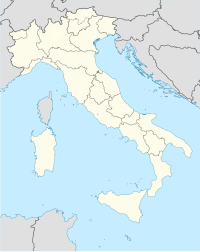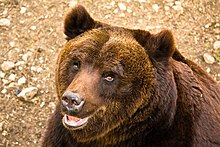
Abruzzo, historically known as Abruzzi, is a region of Southern Italy with an area of 10,763 square km and a population of 1.3 million. It is divided into four provinces: L'Aquila, Teramo, Pescara, and Chieti. Its western border lies 80 km (50 mi) east of Rome. Abruzzo borders the region of Marche to the north, Lazio to the west and north-west, Molise to the south and the Adriatic Sea to the east. Geographically, Abruzzo is divided into a mountainous area in the west, which includes the highest massifs of the Apennines, such as the Gran Sasso d'Italia and the Maiella, and a coastal area in the east with beaches on the Adriatic Sea.

The Province of Teramo is a province in the Abruzzo region of Italy. Its capital is the city of Teramo. The province has an area of 1,948 square kilometres (752 sq mi), a population of 313,029 (2012), and is subdivided into 47 comunes, see Comunes of the Province of Teramo. The Province of Teramo shares its northern border with the Province of Ascoli Piceno in the Marche Region, southern and southwestern borders with the Province of L'Aquila in the Abruzzo Region, and a western border with the Province of Rieti in the Region of Lazio. To the south is the Abruzzo Province of Pescara and to the east is the Adriatic Sea.
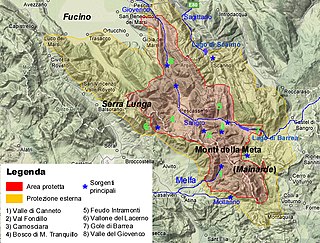
Abruzzo, Lazio and Molise National Park is an Italian national park established in 1923. The majority of the park is located in the Abruzzo region, with smaller parts in Lazio and Molise. It is sometimes called by its former name Abruzzo National Park. The park headquarters are in Pescasseroli in the Province of L'Aquila. The park's area is 496.80 km2 (191.82 sq mi).

Lama dei Peligni is a comune and town in the Province of Chieti in the Abruzzo region of Italy with 1,155 inhabitants. It is also part of the Aventino-Medio Sangro mountain community and the municipal territory is included in the Majella National Park. The town, known to naturalists as the country of chamois, is located in a florofaunal area of particular interest.
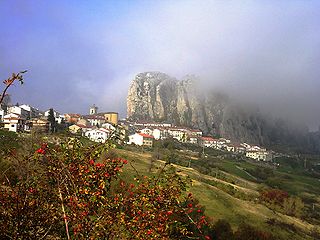
Pizzoferrato is a comune and town in the Province of Chieti in the Abruzzo region of Italy.
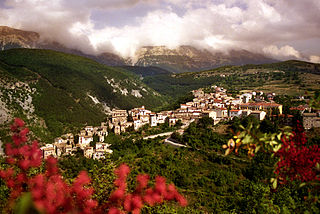
Cansano is a comune in the province of L'Aquila in the Abruzzo region, Southern Italy. It is part of the Maiella National Park. Cansano is known for the archaeological discovery of the Roman village of Ocriticum, which has become an archaeological park.
Sant'Eufemia a Maiella is a town and comune in the province of Pescara, Abruzzo, central Italy. It is located in the Maiella National Park in a valley enclosed by the western slopes of the Majella massif, and the northeastern slopes of the Morrone group.

The Gran Sasso and Monti della Laga National Park is a natural park in central Italy. Established in 1991, it covers an area of 2,014 square kilometres (778 sq mi), mostly within the provinces of Teramo, L'Aquila, and Pescara in Abruzzo, with small areas in the provinces of Rieti in Lazio and Ascoli Piceno in Marche. The terrain is predominantly mountainous with alpine plains.
The Giardino Botanico Daniela Brescia is a botanical garden located in the Majella National Park at an altitude of 900 meters above sea level, Sant'Eufemia a Maiella, Abruzzo, Italy. It is open daily in the summer, and weekends otherwise.
The Giardino Botanico della Majella, also known as the Giardino Botanico Michele Tenore, is a botanical garden located in the Majella National Park at Via Colle della Madonna I-66010, Lama dei Peligni, Province of Chieti, Abruzzo, Italy. It is open daily; an admission fee is charged.

The Maiella is a massif in the Central Apennines, in Abruzzo, central Italy.

The Apennine deciduous montane forests are a temperate broadleaf and mixed forests ecoregion in the Apennine Mountains of Italy. The development of these forests is ensured by the high rainfall in the Apennines, combined with a temperate-cool climate. Because of climate change, the presence of silver fir, although still widespread, has been dramatically reduced in favour of beech.
The TaskForceMajella (TFM) is an industry-funded geoscientific research project conducted between the years 1998 and 2005. The project involved numerous universities distributed worldwide, and was sponsored by a number of international major oil companies. The area of research was the Majella Mountain in Central Italy, regarded as an analogue of a faulted and fractured hydrocarbon reservoir as can be found in major provinces like the Middle East, Caspian Basin, Mediterranean Basin, and other areas. The scope was to obtain knowledge on the relation between fracture and fault generation, and all types of geological aspects of the evolution of the geological structure.

Tourism in Abruzzo has become one of the most prosperous sectors in the economy of Abruzzo, and in recent years has seen a remarkable growth attracting numerous tourists from Italy and Europe. According to statistics, in 2021 arrivals totaled 1,330,887. A total of 5,197,765 arrivals were tourists, a figure that puts the region seventeenth among the Italian regions for numbers of tourists per year. A moderate support to tourism is also given to the Abruzzo Airport with many low cost and charter flights connecting the entire region with the rest of Europe.
Galium magellense, Maiella bedstraw, is a plant species of the Rubiaceae. It is named for the Maiella mountains of central Italy, with the range extending from the Maiellas south along the Apennines to Calabria.

Eremo di Sant'Angelo is an hermitage located in Palombaro, Province of Chieti.

Eremo di Santo Spirito a Majella is an hermitage located in Roccamorice, Province of Pescara.

Monte Cornacchia is a mountain of the Apennine Mountains located in the western internal sector of the province of Foggia. It is the highest peak in the Daunian Mountains and the Apulia region.
The 1706 Abruzzo earthquake, also known as the Maiella earthquake, occurred on November 3 at 13:00 CEST. The earthquake with a possible epicenter in the Central Apennine Mountains (Maiella), Abruzzo had an estimated moment magnitude of 6.6–6.84 Mw . It was assigned a maximum Mercalli intensity of XI (Extreme), causing tremendous destruction in Valle Peligna. At least 2,400 people were killed.
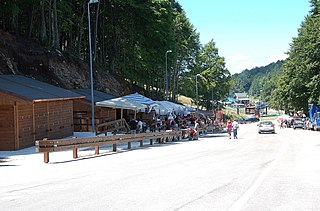
Passolanciano-Maielletta is a ski area of italy, located in the Apennine Mountains, on the north-eastern slope of the Maiella massif, inside of the Maiella National Park, in the territory of the municipalities of Pretoro, Rapino and Pennapiedimonte and Roccamorice in Abruzzo, Italy. Born in the mid-nineties, it consists of two different ski resorts that are neighboring, but not directly connected to each other in terms of skiing: that of Passo Lanciano and that of the Maielletta located along the road that first climbs up to the Bruno Pomilio refuge and then up to Blockhaus, with a catchment area aimed mainly at the lower Abruzzo with the provinces of Pescara and Chieti.

